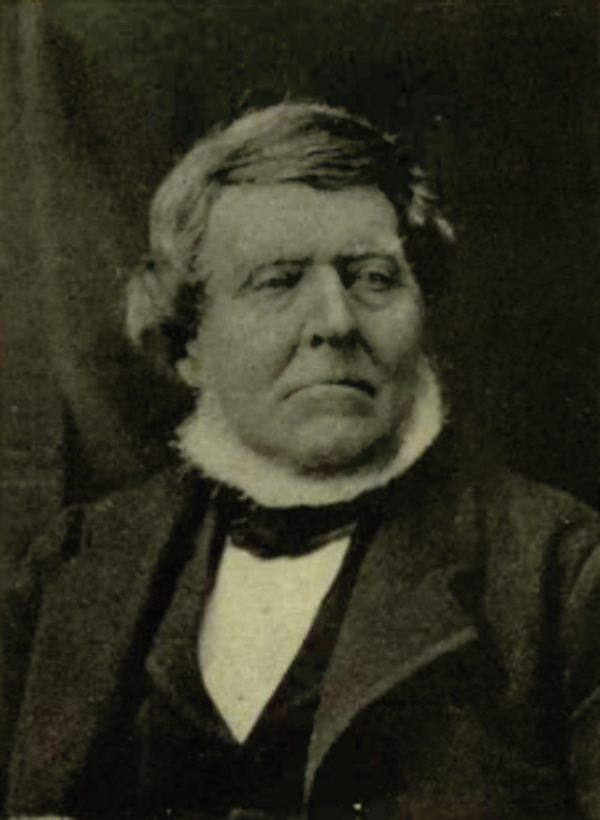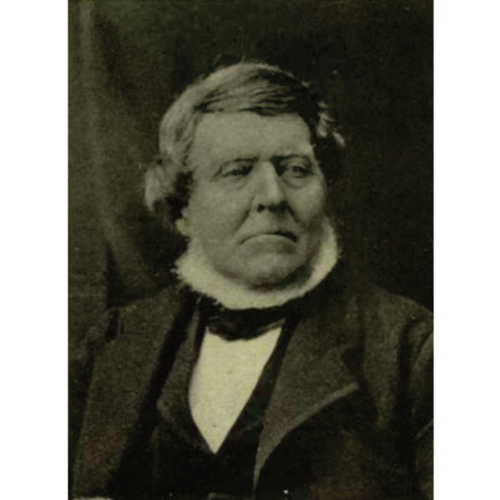
Source: Courtesy of Wikimedia Commons
ANDERSON, THOMAS BROWN, merchant, banker, member of the Special Council for Lower Canada; b. June 1796 in Edinburgh, Scotland; d. 28 May 1873 in Montreal.
Little is known of Thomas Brown Anderson’s early life. Sometime before 1827 he came to Montreal and worked as a clerk in the commercial firm of Forsyth, Richardson and Company, which in copartnership with Forsyth, Walker and Company of Quebec, traded in furs, wholesale provisions, and real estate, acted as the East India Company’s Canadian agent, and served as the financial repository for the receiver-general’s department of Lower Canada. Anderson’s marriage on 12 Dec. 1827 to Ann Richardson (widow of David Ogden), eldest daughter of John Richardson*, a senior partner in Forsyth, Richardson and Company, undoubtedly assisted his business career; he became the company’s last president. His only child, Elizabeth Magdalene, became the wife of Lieutenant-Colonel Joseph Bell Forsyth.
In 1847, when the major shareholders in Forsyth, Richardson and Company withdrew their capital, Anderson dissolved the copartnership with Forsyth, Walker and Company and reorganized the Montreal business under the name of Anderson, Auldjo and Company. Anderson’s partners, Louis Auldjo, William Evans, and Thomas Forsyth, had also been clerks with Forsyth, Richardson and Company. In 1852 Auldjo left the company to establish his own business, and Anderson’s firm became Anderson, Evans and Company, hardware merchants and importers. In 1858 Thomas and Samuel Evans joined the company and its name was changed to Anderson, Evans and Evans. This partnership was dissolved in 1861 and Anderson thereafter devoted his full time to banking.
Anderson, the son-in-law of one of the Bank of Montreal’s most prominent founders and shareholders, served as a director of this bank from 1830 until 1834 and again from 1835 until his retirement in 1869. In 1837 he worked on a directors’ committee to determine the bank’s policy toward the exchange crisis of that year. In 1840 he supported the efforts of Peter McGill*, the bank’s president, to extend its operations into Upper Canada; and a year later he represented the Bank of Montreal before the Legislative Assembly’s committee on money and banking to request stronger legislation to facilitate branch banking in Canada. On 8 June 1847 Anderson succeeded Joseph Masson* as vice-president of the Bank of Montreal and, on 5 June 1860, when old Peter McGill retired, Anderson was unanimously elected to succeed him.
Although Anderson has been described as “one of the old race of Canadian merchants” he readily recognized the change in the country’s economy away from its old mercantile base to a more sophisticated corporate structure, and he reorganized the Bank of Montreal’s business and administration to profit from this change. From 17 April 1855 he had served as chairman of the Canadian board of directors for the Liverpool, London Fire and Life Insurance Company. (This position he retained until 20 July 1872; thereafter he remained a director of the company, at the board’s request, until his death.) When he became president of the Bank of Montreal he authorized branch bank managers and agents to represent insurance companies and other corporate interests. In 1862 Anderson created the post of general manager and selected a clever Scottish banker, David Davidson, as its first occupant. When Davidson retired a year later Anderson promoted Edwin H. King*, later known as “the king of Canadian bankers,” to fill Davidson’s place; this young, shrewd, and skilful Irish banker, who succeeded Anderson as president, soon justified Anderson’s confidence. During the American Civil War, the north’s chronic need for credit, Canada’s ready access to English gold, and King’s knowledge of the American money market enabled the Bank of Montreal to exploit the situation to its advantage.
In November 1863 the Bank of Montreal wrested the Canadian government’s account from its chief rival, the floundering Bank of Upper Canada. This account, owing to the government’s extravagant financial commitments, seemed at times a dubious asset, but provided the Bank of Montreal with a position of valuable influence, which it rarely hesitated to use. In 1866, for example, the bank, despite the opposition of its rivals, persuaded the government to enact legislation enabling banks to convert specie and government debentures into provincial notes, legislation from which it, as the government’s banker, stood most to gain. The next year, John A. Macdonald*, upon E. H. King’s advice and contrary to that of his minister of finance, Alexander Tilloch Galt*, refused to assist the faltering Commercial Bank of the Midland District, the Bank of Montreal’s chief rival following the failure of the Bank of Upper Canada. Consequently “one of the most powerful and seemingly most substantial institutions in the country” failed.
Despite Anderson’s cautious and, at times, pessimistic annual reports, the Bank of Montreal thrived under his administration. In nine years deposits trebled, owing, in part, to the flight of American capital during the Civil War; gold, silver, and coin holdings and government debentures increased, adding to the stability of the institution. On 20 Oct. 1869 Anderson retired from the Bank of Montreal for reasons of health. He had developed a speech impediment probably caused by a slight stroke. The bank directors voted him a stipend of $2,000 in recognition of his faithful services.
Although Thomas Anderson retained a lively interest in British politics, remaining a devoted Tory, he, unlike many other prominent Montreal merchants of his day, played a relatively inconspicuous part in municipal or provincial politics. On 2 April 1838, the governor, the Earl of Gosford [Acheson*] appointed Anderson to the Special Council for Lower Canada, a position he retained only until 1 June 1838. In 1849 Anderson joined the Annexation Association, became one of its eight vice-presidents, and signed the Annexation Manifesto.
Anderson readily supported a variety of civic, charitable, religious, and educational organizations. In 1829 he joined the executive of the recently organized Montreal Committee of Trade, which in 1842 became the Montreal Board of Trade. Although he was never president of the Board of Trade, in 1849 he was chosen vice-president and he served on the executive council and board of arbitration continuously from 1842 until 1850. He acted as treasurer of the Montreal General Hospital, an institution to which his father-in-law had contributed liberally. He supported the Longueuil Mission. His wife also assisted charitable works; her principal interests were the Lying-in Hospital and the Ladies Benevolent Society, which her mother had reorganized in 1832. Although not of the Presbyterian faith, Anderson, like many Scottish Montreal merchants, retained a pew in the St Gabriel Street Church. A devoted Anglican and member of the Christ Church Cathedral congregation, and later of St James the Apostle, he actively participated in parish and diocesan work. In 1856 he joined a committee of 11 to draw up plans for the construction of the new Christ Church Cathedral. He also served as the financial secretary of the parochial endowment fund, investing some of its money in Bank of Montreal shares. From 2 May 1845 until his death Anderson was a member of the board of governors of McGill University, during which time he served on many committees and contributed generously to the original McGill endowment fund. From 1851 until 1852 he was vice-chairman of the board and thereafter first member of the finance committee.
Thomas Brown Anderson, through cautious methodical management and a fortunate marriage, enjoyed a successful business career in Montreal and made a definite if moderate contribution to its public life.
AJM, Registre d’état civil, Christ Church parish, 12 Dec. 1827; Registre d’état civil, St James the Apostle parish, 1873. PAC, MG 24, I79 (T. B. Anderson papers). McGill University Archives, Dawson papers; Minutes of the board of governors, 1851–74. Annual report of the governors, principal, and fellows of McGill University, Montreal . . . , 1851–73. [Bruce and Grey], Elgin-Grey papers (Doughty), IV, 1493. Canada, Province of, Sessional papers, XVIII (1860), pt.1, no.5; XXI (1863), pt.3, no.9. Canada Gazette (Quebec), 15 May, 3 July 1847. Gazette (Montreal), December 1827, 17 May–4 Aug. 1847, May 1873. Montreal Herald, May–June 1873. Montreal Transcript, May–November 1836. Montreal Witness, May 1873. L’Opinion publique (Montréal), 27 mai–11 juin 1873. Canada directory, 1851–73. The Canadian men and women of the time: a handbook of Canadian biography, ed. H. J. Morgan (1st ed., Toronto, 1898). Desjardins, Guide parlementaire. Montreal directory (Mackay), 1842–50. McGill University calendar, 1856–73. Canadian banking and monetary policy: recent readings, ed. J. P. Cairns and H. H. Binhammer (Toronto, 1965). Denison, Canada’s first bank, I. W. R. Graham, “Sir Richard Cartwright and the Liberal party, 1863–1896,” unpublished phd thesis, University of Toronto, 1950. Cyrus Macmillan, McGill and its story, 1821–1921 (London, New York, Toronto, 1921), 207. G. H. S. Mills, “The annexation movement of 1849–1850 as seen through Lower Canadian press,” unpublished ma thesis, McGill University, 1947. O. D. Skelton, The life and times of Sir Alexander Tilloch Galt (Toronto, 1920). F.-J. Audet, “Membres du Conseil spécial,” BRH, VII (1901), 82–83. J. I. Cooper, “The origins and early history of the Montreal City and District Savings Bank, 1846–1871,” CCHA, Report, 1945–46, 15–25. George Hague, “The late Mr. E. H. King, formerly president of the Bank of Montreal: some personal reminiscences,” Journal of the Canadian Bankers Association (Toronto), IV (1896–97), October 1896, 20–29. D. C. Masters, “Toronto vs. Montreal; the struggle for financial hegemony, 1860–1875,” CHR, XXII (1941), 141–42. Adam Shortt, “Founders of Canadian banking: the Hon. John Richardson, merchant, financier and statesman,” Journal of the Canadian Bankers Association (Toronto), XXIX (1921–22), October 1921, 17–27; January 1922, 165–78.
Cite This Article
Carman Miller, “ANDERSON, THOMAS BROWN,” in Dictionary of Canadian Biography, vol. 10, University of Toronto/Université Laval, 2003–, accessed December 28, 2025, https://www.biographi.ca/en/bio/anderson_thomas_brown_10E.html.
The citation above shows the format for footnotes and endnotes according to the Chicago manual of style (16th edition). Information to be used in other citation formats:
| Permalink: | https://www.biographi.ca/en/bio/anderson_thomas_brown_10E.html |
| Author of Article: | Carman Miller |
| Title of Article: | ANDERSON, THOMAS BROWN |
| Publication Name: | Dictionary of Canadian Biography, vol. 10 |
| Publisher: | University of Toronto/Université Laval |
| Year of publication: | 1972 |
| Year of revision: | 1972 |
| Access Date: | December 28, 2025 |



